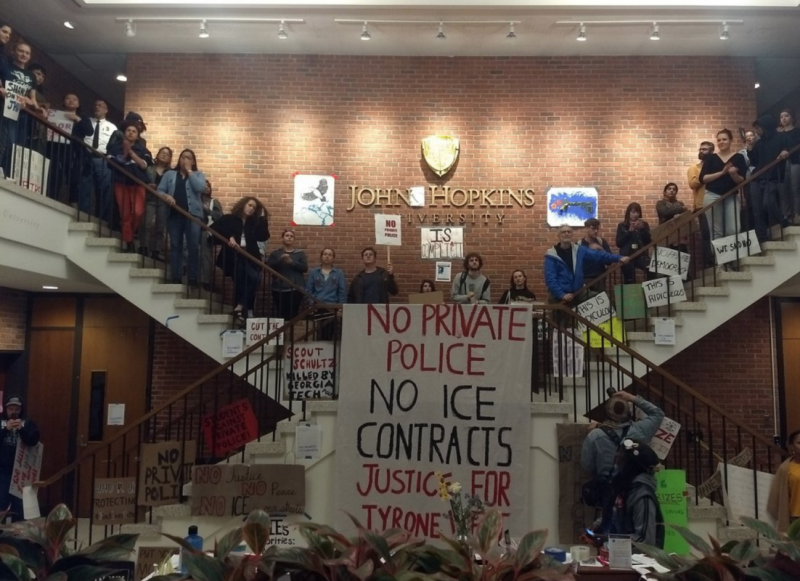
By Ryan Paul
Between April 3rd and May 8th of 2019, a sit-in protest took place at Garland Hall, John’s Hopkins University (JHU) in Baltimore, MD. It came to be known by university press and other media as the “Garland Hall Sit-In”. Participants in the protest during its month-long duration claimed that it had become a safe space for minorities and marginalized groups to voice their concerns and harsh experiences at the campus in regards to discrimination while also becoming a vehicle for direct democratic decision making. Many felt they had begun to create a “leaderless movement” which involved direct democracy, and was inclusive to everyone.
The students of JHU have been organizing since at least 2018 around two central issues. First, the proposed creation of a private police force by the university and second, the ongoing contracts with ICE which the university has been harshly criticized for. In 2018 teach-ins, sit-ins and other forms of agitation and education were launched by groups like the Baltimore International Socialist Organization (ISO). Also formed during this time was the faculty and student coalition Hopkins Coalition Against ICE (HICE). In April 2019 these coalitions as well as many other student organizations and non-student community members united and staged the sit-in at Garland Hall. It ended on May 8th at 4:30am when police forcefully evacuated Garland Hall, making arrests, and disrupting the organizers in what was the “largest police action directed towards students in Johns Hopkins history.”
While the sit-in protest was ultimately crushed by state force, some important lessons remain for advocates of direct action and collective self-management. Multiple interviews with students involved in the sit-in, as detailed in the “Homewood Faculty Assembly Fact Finding Committee Report on the Garland Hall Sit-In”, show that a real sense of community and democratic involvement had begun to flourish. This was reinforced and fueled by the general feeling of acceptance many students felt at the time. The report states that even within the first few days “the small number of initial occupiers, who were well organized and ready to be arrested, transformed into a leaderless, democratic grouping, which staged teach-ins alongside rallies, collective meals alongside wide-ranging debates” and that “students described the transformation of Garland Hall into a space where students could recount experiences of marginalization and racial profiling on campus”. One student interviewed in the report also said that “…it was beautiful. It was seeing what a university could be like. We would have tutoring sessions. People would give lectures. It was a beautiful community.”
Sources:
https://www.jhunewsletter.com/article/2019/09/university-will-not-renew-its-contracts-with-ice
https://www.insidehighered.com/news/2020/01/02/hopkins-faculty-investigates-spring-sit
https://facultyassembly.jhu.edu/files/2019/12/Homewood-Faculty-Assembly-Fact-Finding-Committee-Report.pdf
https://truthout.org/articles/why-is-johns-hopkins-enabling-ice/
